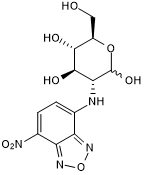All AbMole products are for research use only, cannot be used for human consumption.

2-NBDG is a fluorescently-labeled deoxyglucose analog that is used primarily to directly monitor glucose uptake by living cells and tissues. 2-NBDG can be used in real-time confocal, high-resolution, or wide-field fluorescence microscopy as well as in flow cytometry. The probe can be excited by the Argon laser at 488 nm to give the environment-sensitive fluorescence.

Cell Rep. 2025 Jun 25; .
Identifying the target, mechanism, and agonist of α-ketoglutaric acid in delaying mesenchymal stem cell senescence
2-NBDG purchased from AbMole

Cell Death Dis. 2024 Apr 15;15(4):267.
Scutellarin activates IDH1 to exert antitumor effects in hepatocellular carcinoma progression
2-NBDG purchased from AbMole

Arch Pharm Res. 2024 Feb;47(2):127-145.
Prenylated flavonoid fractions from Glycyrrhiza glabra alleviate insulin resistance in HepG2 cells by regulating the ERK/IRS-1 and PI3K/Akt signaling pathways
2-NBDG purchased from AbMole

J Diabetes. 2023 Aug 18.
Decreased in n-3 DHA enriched triacylglycerol in small extracellular vesicles of diabetic patients with cardiac dysfunction
2-NBDG purchased from AbMole

Patent. CN116059199B 2023 Jul 18.
Patent. CN116059199B
2-NBDG purchased from AbMole

Nano Today. 2022 August;101541.
Dual regulation on oxidative stress and endoplasmic reticulum stress by [70] fullerenes for reversing insulin resistance in diabetes
2-NBDG purchased from AbMole

Biofabrication. 2022 May 26;4(3).
Dual-core coaxial bioprinting of double-channel constructs with a potential for perfusion and interaction of cells
2-NBDG purchased from AbMole

Proteomics Clin Appl. 2022 Jan;16(1):e2100031.
Quantitative proteomics analysis reveals novel insights into mechanisms of action of disulfiram (DSF)
2-NBDG purchased from AbMole

Front Immunol. 2021 Aug 26;12:728082.
Brd4 Regulates the Homeostasis of CD8+ T-Lymphocytes and Their Proliferation in Response to Antigen Stimulation
2-NBDG purchased from AbMole
| Molecular Weight | 342.26 |
| Formula | C12H14N4O8 |
| CAS Number | 186689-07-6 |
| Form | Solid |
| Solubility (25°C) | DMSO 14 mg/mL |
| Storage | -20°C, protect from light |
| Related Fluorescent Dye Products |
|---|
| DSPE-Rhodamine
DSPE-Rhodamine is formed by the conjugation of DSPE with the Rhodamine fluorescent dye. DSPE possesses a hydrophobic lipid tail and a hydrophilic head group, while Rhodamine is a red fluorescent dye. DSPE-Rhodamine retains the lipid properties of DSPE while also imparting fluorescent labelling capabilities. As a key component of delivery systems, DSPE-Rhodamine enhances targeting and bioavailability. Its lipid properties facilitate the penetration of molecules through cell membranes, while its fluorescent properties enable tracking of distribution and dynamic changes within the body. |
| LD540
LD540 is a novel high-sensitivity lipophilic dye modified with BODIPY fluorescent groups, designed for precise labelling and imaging of lipid droplets. LD540 exhibits excellent photostability and an optimal fluorescence spectrum, making it compatible with various commonly used fluorescent dyes (such as DAPI and Alexa Fluor 647), thereby supporting multi-colour imaging requirements. Additionally, LD540 is suitable for both fixed and live cells and can label ultra-small lipid droplets. |
| PDMPO
PDMPO (Yellow/Blue DND-160) is a ratiometric probe for the determination of lysosomal pH for fluorescence imaging. PDMPO exhibits pH-dependent dual excitation and dual emission peaks. PDMPO produces blue fluorescence (Ex/Em=329 nm/440 nm) in weakly acidic organelles, and in more acidic lysosomes it becomes yellow fluorescence (Ex/Em=384 nm/540 nm). |
| Copper probe CF4
Copper probe CF4 (Copper fluor CF4) is a Cu+-specific fluorescent probe based on a rhodol dye scaffold. Copper probe CF4 (Copper fluor CF4) has high copper selectivity with a Kd value of 2.9×10-13 M, particularly over zinc and iron, as well as abundant cellular alkali and alkaline earth metals. Copper probe CF4 (Copper fluor CF4) is stable in a physiologically relevant pH regime between 6 and 8 (wavelengths of 415 nm for excitation and 660 nm for emission). Copper probe CF4 (Copper fluor CF4) can be used to study colon cancer. |
| Phalloidin-Fluor 647 Conjugate
Phalloidin-Fluor 647 Conjugate selectively binds to F-actins. Used at nanomolar concentrations, phalloidin derivatives are convenient probes for labeling, identifying and quantitating F-actins in formaldehyde-fixed and permeabilized tissue sections, cell cultures or cell-free experiments. |
All AbMole products are for research use only, cannot be used for human consumption or veterinary use. We do not provide products or services to individuals. Please comply with the intended use and do not use AbMole products for any other purpose.


Products are for research use only. Not for human use. We do not sell to patients.
© Copyright 2010-2024 AbMole BioScience. All Rights Reserved.
